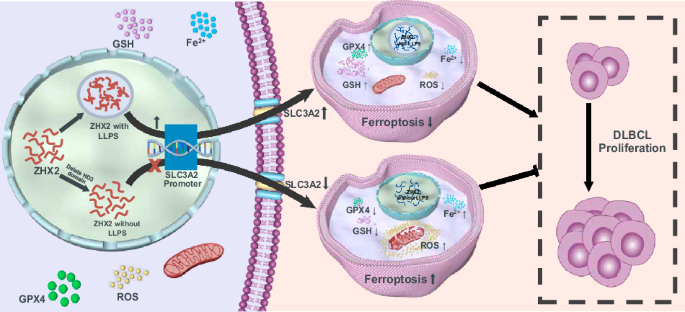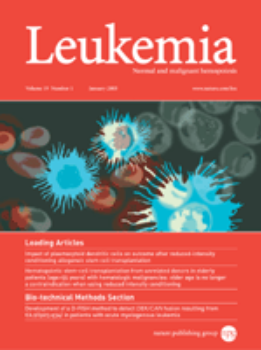液-液相分离的ZHX2通过诱导SLC3A2对DLBCL细胞有保护作用
IF 13.4
1区 医学
Q1 HEMATOLOGY
引用次数: 0
摘要
弥漫性大b细胞淋巴瘤(DLBCL)是最常见的b细胞非霍奇金淋巴瘤(B-NHL),具有侵袭性强、异质性高、预后差的特点。因此,迫切需要确定关键的治疗靶点。我们发现转录因子zn -finger and homeobox 2 (ZHX2)在DLBCL中高表达。随后,ZHX2被证明通过抑制铁下垂促进DLBCL细胞增殖。机制上,ZHX2通过液-液相分离(LLPS)结合到溶质载体家族3-member 2 (SLC3A2)基因的启动子区,激活其负调控铁凋亡的功能。此外,我们构建了靶向DLBCL的脂质纳米颗粒ZHX2-siRNA@LNP,在体内有效抑制了肿瘤的生长。综上所述,我们的研究表明,ZHX2的LLPS通过诱导SLC3A2来保护DLBCL抗铁沉,而ZHX2-siRNA@LNP对其进行干扰可以显著抑制DLBCL,为DLBCL提供了一种很有前景的治疗策略。本文章由计算机程序翻译,如有差异,请以英文原文为准。


Liquid-liquid phase separation of ZHX2 protects DLBCL cells against ferroptosis through induction of SLC3A2
Diffuse large B-cell lymphoma (DLBCL), the most common B-cell non-Hodgkin lymphoma (B-NHL), is characterized by strong aggression, high heterogeneity, and poor prognosis. Consequently, there is an urgent need to identify crucial therapeutic targets. Here, we found that the transcription factor zinc-finger and homeobox 2 (ZHX2) was highly expressed in DLBCL. Subsequently, ZHX2 was proven to be critical for promoting DLBCL cell proliferation by inhibiting ferroptosis. Mechanistically, ZHX2 bound to the promoter region of the solute carrier family 3-member 2 (SLC3A2) gene through liquid-liquid phase separation (LLPS) and activated its function to negatively regulate ferroptosis. Furthermore, we constructed lipid nanoparticles ZHX2-siRNA@LNP targeting DLBCL, which effectively inhibited the growth of the tumors in vivo. In summary, our study indicated that the LLPS of ZHX2 protected DLBCL against ferroptosis through induction of SLC3A2, and disturbing it with ZHX2-siRNA@LNP could significantly repress DLBCL, providing a promising therapeutic strategy for DLBCL.
求助全文
通过发布文献求助,成功后即可免费获取论文全文。
去求助
来源期刊

Leukemia
医学-血液学
CiteScore
18.10
自引率
3.50%
发文量
270
审稿时长
3-6 weeks
期刊介绍:
Title: Leukemia
Journal Overview:
Publishes high-quality, peer-reviewed research
Covers all aspects of research and treatment of leukemia and allied diseases
Includes studies of normal hemopoiesis due to comparative relevance
Topics of Interest:
Oncogenes
Growth factors
Stem cells
Leukemia genomics
Cell cycle
Signal transduction
Molecular targets for therapy
And more
Content Types:
Original research articles
Reviews
Letters
Correspondence
Comments elaborating on significant advances and covering topical issues
 求助内容:
求助内容: 应助结果提醒方式:
应助结果提醒方式:


